Understanding Bernedoodle vs Aussiedoodle
When diving into the delightful world of doodles, the comparison of Bernedoodle vs Aussiedoodle often pops up like a fun riddle. Both breeds charm their way into our hearts, but they each carry distinct traits that set them apart.
First off, let’s talk about the Bernedoodle. This breed, a hybrid of the Bernese Mountain Dog and a Poodle, boasts a robust, gentle demeanor. Imagine a fluffy giant who loves to cuddle; that’s your Bernedoodle!
On the other hand, the Aussiedoodle, the offspring of an Australian Shepherd and a Poodle, brings a whirlwind of energy to the table. These dogs are like the lively dancers of the canine world, always ready to engage in playtime or an adventure.
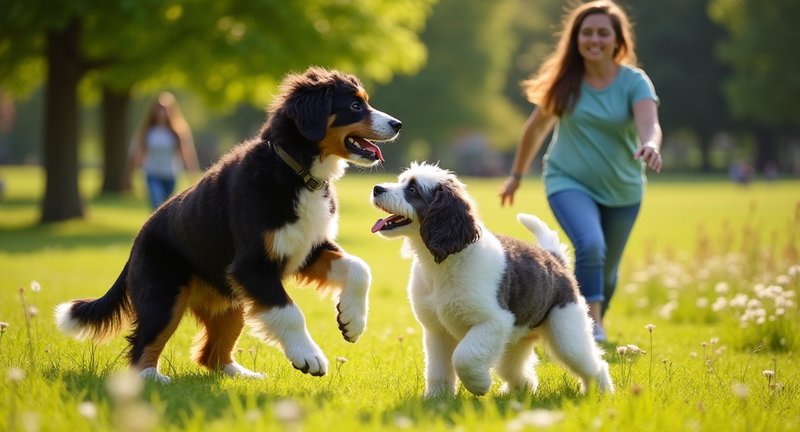
Now, let’s not overlook the size difference. Bernedoodles come in various sizes but generally lean towards the larger side. In contrast, Aussiedoodles tend to be more medium-sized, perfect for those who live in cozy spaces but still crave a playful companion.
Grooming is another fun factor in the Bernedoodle compared to aussiedoodle debate. The Bernedoodle’s luscious coat may require a bit more attention, while the Aussiedoodle’s often wavy fur can be a little less demanding. But don’t let that fool you; both breeds still need regular grooming to keep them looking their best.
At the end of the day, whether you find yourself enchanted by the gentle giant or the energetic whirlwind, both breeds promise joy, loyalty, and a sprinkle of mischief.
Bernedoodle Vs Aussiedoodle: A Comparison
When it comes to choosing between two incredibly intelligent and loving dogs, it’s like deciding between your favorite flavors of ice cream. You know both are going to be good, but each one has a different twist. Take these two delightful mixes – each one brings its own charm to the table, yet their personalities couldn’t be more distinct.
In my experience, if you’re drawn to a dog that feels like a big, soft teddy bear, you’ll be enchanted by one of these. There’s something about the way they curl up next to you, offering comfort in their own gentle, intuitive way. But if you’re looking for a spirited, high-energy companion, the other might win your heart with boundless enthusiasm and a playful spark that never seems to dim.
While one mix tends to be a little more reserved, reflecting a calm, almost old-soul vibe, the other is a burst of sunshine, ready to leap into action at a moment’s notice. Whether you crave quiet moments or adventure-filled days, there’s a dog for that, and I’ve seen how each thrives in their own environment.
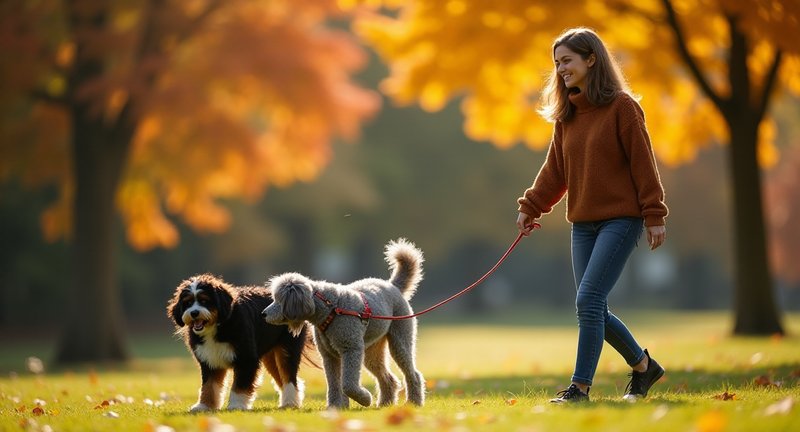
The physical differences? They’re subtle but noticeable. One can look a little more robust, with that classic mountain dog flair, while the other often sports a sleek, athletic build, reflecting its herding lineage. Both are undeniably adorable – it’s just a matter of which style speaks to your heart more.
Whichever you choose, you’re in for a lifetime of loyalty and love, but one might fit your lifestyle just a smidge better than the other. Trust me, there’s no wrong choice here.
Introduction to Hybrid Dog Breeds
When I first stumbled upon hybrid dog breeds, I was honestly fascinated. These aren’t your standard dogs; they’re blends of two distinct breeds, and it creates something truly unique. You’ll often see traits from both parents, and that’s where the magic happens.
Hybrids, like those popular doodle crosses, bring out the best of both worlds. The right mix can soften certain traits while amplifying others. It’s like crafting a recipe with all the best ingredients, hoping for the perfect flavor.
But here’s something I didn’t expect: their personalities can be a delightful mix of surprises. One day, they’ll be independent like one parent breed, and the next day, they’ll be affectionate and clingy like the other. It keeps life interesting.
I also noticed how varied their appearances can be. No two hybrids look exactly alike, even if they’re from the same litter. One pup might have curly fur while its sibling has straighter, sleeker hair.
In my experience, hybrid dogs often come with a range of temperaments. Sometimes they are highly energetic, while at other times they seem calm and collected. It really depends on which breed’s genes take the lead that day. And if you’re wondering about their health, it’s said that hybrids might benefit from ‘hybrid vigor’ – they could be less prone to certain hereditary health issues.
So if you’re thinking about adopting one, be ready for a bit of unpredictability. But trust me, it’s the kind of unpredictability that enriches your life, not complicates it. Hybrids are all about celebrating diversity in every wag of their tail.
Overview of the Bernedoodle
The Bernedoodle is one of those mixed breeds that instantly wins hearts with its charm and personality. A cross between a Bernese Mountain Dog and a Poodle, it brings together the best traits of both worlds. I’ve seen firsthand how this breed combines the calm, affectionate nature of the Bernese with the intelligence and hypoallergenic coat of the Poodle. It’s a combination that creates a dog perfect for families, individuals, or even those with allergies.
What stands out most to me about the Bernedoodle is its versatility in size. They come in a variety of sizes based on the Poodle parent standard, mini, or even tiny. This makes it easy for potential owners to find a dog that fits their living space, whether it’s a small apartment or a big suburban home.
One of the things that often surprises people is how well Bernedoodles adapt to different environments. Whether it’s a high-energy household with kids or a quieter space, they seem to mold themselves into the perfect companion. A few other highlights of this breed include:
- Affectionate nature: Bernedoodles love their people and tend to form deep bonds with their families.
- Playfulness: They are great with kids and often have a goofy, playful side that can brighten anyone’s day.
- Low shedding: While no dog is completely hypoallergenic, Bernedoodles shed much less than many other breeds, thanks to their Poodle parent.
However, don’t let their cuteness fool you they’re smart and need mental stimulation. So if you’re not ready to provide that, a Bernedoodle may keep you on your toes!
Characteristics of the Aussiedoodle
The Aussiedoodle, in all its curly-coated glory, is one of those dogs that grabs your attention and never lets go. With its mix of Australian Shepherd and Poodle, you’re looking at a breed that’s as clever as it is charming. I remember the first time I met one I thought, ‘This dog could outsmart me if it really wanted to.’ And I wasn’t wrong.
These pups are little energy dynamos. If you’re an active person, they’ll be more than happy to join you on hikes or even pick up on agility training with ease. But don’t let their energy fool you; they’re just as content to curl up next to you after a day of adventure. It’s that blend of playful and mellow that makes them so special.
What really stands out is their intelligence. The Aussie heritage brings a sharpness to their instincts, while the Poodle’s smarts add a little extra finesse. They seem to learn tricks and commands quicker than you’d expect, and sometimes, they make you feel like they’re training you. The way they look at you, almost as if they’re figuring you out, is uncanny.
Aussiedoodles also have this amazing variety when it comes to coat colors and patterns. You could have a merle, a solid, or a patchwork of colors that would make any dog lover do a double-take. And the best part? That coat is hypoallergenic, which is a blessing for anyone who struggles with pet allergies but still wants a cuddly companion.
Comparing Size and Weight
When discussing size and weight, there’s more than meets the eye. You wouldn’t think so at first glance, but the variations are pretty impressive. Depending on the parentage and genetics, these dogs can range from a petite companion to a larger, more robust furry friend. It’s almost like rolling the dice, and what you get can be a delightful surprise.
Some of them stay on the smaller side, perfect for those who prefer a lap dog with just the right amount of fluff. Others, though, grow into a size that might make you wonder if they realize they’re not a lap dog anymore. I’ve seen a few that try anyway, despite their bulk!
Weight is another interesting factor. It’s not just about how much they weigh but how they carry it. Some have that compact, muscular build, where you can tell every pound counts. Others are more on the leaner side, with weight spread out in a way that makes them look almost graceful if you can call a dog graceful, that is.
The decision about size often comes down to your living space and lifestyle. If you’re in a smaller apartment, going for one of the lighter-weight, more compact variations might just save your couch from total dog domination. On the flip side, if you’ve got the room and the desire for a more substantial companion, a bigger dog can be the perfect fit for your household.
In my experience, it’s always good to see them in person before deciding. Pictures don’t always do justice to their size and presence, and it’s important to feel the connection with the dog in real life.
Coat Types and Grooming Needs
In the matter of coat types, there’s quite a range. You’ll see everything from the straight, easygoing fur to the tighter, more challenging curls. I’ve spent hours brushing through both kinds, and I can tell you your grooming routine will depend heavily on which coat your doodle sports.
For straight or wavy coats, grooming is usually a breeze. You won’t be fighting tangles as often, but that doesn’t mean you can skip a regular schedule. A weekly brushing session will keep things neat and help minimize shedding, which is always a win, right?
Now, if you’re dealing with the curly type, get ready for a bit more commitment. These coats love to tangle. I’ve found that daily brushing can save you from those dreaded mats. And trust me, you don’t want to deal with mats they turn into little puzzles for your brush to solve.
Another thing to consider is how the seasons affect grooming. Warm weather can lead to shedding spikes, even in dogs that are typically low-shedders. In colder months, those curls tend to get thicker, demanding even more attention. A good pair of grooming scissors or a regular trip to a professional can make life easier during these times.
Oh, and don’t forget to trim those paws! The fur between the toes tends to grow out like wild grass. It’s a little thing, but it makes a world of difference in keeping your pup comfortable.
Temperament and Personality Traits
As for temperament and personality traits, these delightful furry companions often mirror both their parent breeds and the environment they’re raised in. From my own experience, I can confidently say that their unique personalities are nothing short of a captivating blend of charm and energy.
If you’ve ever found yourself wondering what type of dog would suit your lifestyle best, it’s essential to consider temperament, as it can vary significantly. Here are some key personality traits that are common, though you might be surprised by how individual each dog can be:
-
Affectionate Nature: Some are incredibly loving and thrive on human interaction, often nudging your hand for that extra pet or cuddle. If you’re someone who enjoys constant companionship, you’ll be in for endless snuggles.
-
High Energy: Many love to stay active, so expect plenty of playful antics and a drive for exercise. If you’re more of a couch potato, you might want to think twice before bringing one home!
-
Adaptability: These dogs can be both relaxed at home and lively outdoors. It’s this adaptability that makes them excellent companions whether you’re living in an apartment or a house with a big yard.
-
Intelligent & Curious: With a knack for learning new tricks, they’ll often surprise you with their clever ways. You’ll find they pick up commands quickly, though you may also notice a streak of stubbornness!
From my perspective, you’re not just adopting a dog; you’re welcoming a loyal, vibrant personality into your life. So, when considering what kind of canine suits you, think not only about appearance but about the temperament that matches your own.
Bernedoodle vs Aussiedoodle: An Insightful Deep Dive
With a focus on choosing between a Bernedoodle and an Aussiedoodle, the decision isn’t as straightforward as it might seem. I’ve spent some time around both breeds, and trust me, their personalities and needs can be quite different. Let’s break it down so you can make an informed choice without getting lost in the ‘Bernedoodle vs Aussiedoodle’ debate.
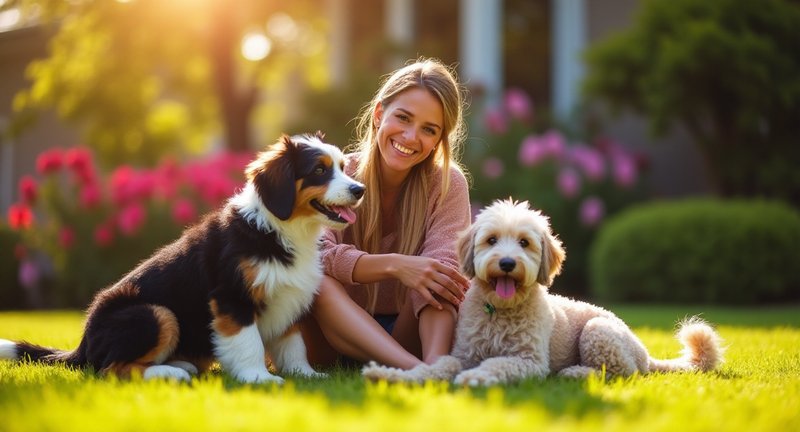
Temperament
- Bernedoodles are typically laid-back and loyal. They love being part of the family, and I’ve noticed they often act like a big, fluffy shadow, always wanting to be nearby. Think of them as the gentle giant of doodles.
- Aussiedoodles, on the other hand, are bursting with energy and curiosity. If you’re someone who loves being on the move or enjoys mental stimulation, you’ll get along with an Aussiedoodle’s boundless enthusiasm and intelligence.
Size & Appearance
- Bernedoodles tend to be on the larger side, especially when they take after their Bernese Mountain Dog parent. I’ve seen some that grow to be almost too big for your lap (though they’ll try!).
- Aussiedoodles are more medium-sized, with a sleeker, sportier look. Their Australian Shepherd parent lends them a more athletic build, and they often have those mesmerizing merle or tricolor coats.
Energy Levels
- If you’re more of a Netflix-and-chill type, Bernedoodles are content with a good walk and then lounging the rest of the day.
- Aussiedoodles need more mental and physical stimulation, so be ready for lots of playtime and interactive activities.
At the end of the day, the choice between a Bernedoodle and an Aussiedoodle boils down to your lifestyle and what you value in a companion. Personally, I’m a fan of both, but their needs couldn’t be more different.
Energy Levels and Exercise Requirements
When we talk about energy levels in dogs, it’s like comparing fuel-efficient hybrids with sports cars. Every dog has their unique pace, and trust me, you’ll feel the difference in your daily routine. You might wonder, will this furry friend push me to jog five miles, or are they content with a lazy afternoon cuddle?
Exercise requirements can vary as wildly as the seasons. One day, you might be racing through the park with a dog whose energy seems to have no end. The next, you could find yourself in a tug-of-war over who gets to stay on the couch. It’s all about balance – theirs and yours.
Some dogs will surprise you with bursts of speed that make you wonder if they’ve been watching Olympic sprints in their spare time. Others are more of a steady, all-day kind of mover, needing multiple short bursts of play rather than an epic adventure. And believe me, you’ll know the difference after the first week.
It’s not just about wearing them out. Their energy has a direct link to their happiness and health. Miss a day of proper exercise, and suddenly, you might have a dog trying to turn your living room into a race track. That’s when you realize just how vital those walks, runs, or games of fetch are – not just for them, but for your sanity too.
So, whether your dog is a marathoner or a sprinter, you’ll quickly learn how much movement they crave. And, let’s be honest, keeping up with their needs might just turn you into a fitness enthusiast yourself.
Health Concerns for Each Breed
When we dive into the health of each breed, it’s like opening a Pandora’s box some things you expect, others surprise you. Every breed has its quirks, and trust me, they’re not all sunshine and rainbows. Take larger breeds, for instance. They often grapple with joint issues as they age, especially if they lead a sedentary life. Watching out for early signs like limping or stiffness can make all the difference in keeping them active.
Smaller breeds, on the other hand, seem to face more dental challenges. I’ve seen it time and again, where ignoring basic dental care can lead to a host of other problems. You wouldn’t believe how much a little extra attention to brushing those pearly whites can save you (and them) down the road.
For some of the hybrid breeds, there’s a bit of a genetic lottery involved. They can inherit the best or the worst of both worlds. I’ve had my fair share of encounters with breeds prone to hip dysplasia or eye issues, and it’s always better to catch these early on.
And let’s not forget the environmental impact. Some breeds are more sensitive to their surroundings than others, whether it’s allergens or even certain foods. I always tell folks, pay attention to what your pet reacts to it can save them from chronic discomfort.
Health is just as much about prevention as it is about treatment. Regular vet checkups and a solid understanding of what your breed is prone to will keep you ahead of the curve. Trust me, it’s all about staying one step ahead.
Lifespan of Bernedoodles and Aussiedoodles
From my experience with both Bernedoodles and Aussiedoodles, I can tell you their lifespan is a delightful topic to explore. These charming companions tend to stick around for a solid chunk of time, though there are some slight differences between the two.
Bernedoodles, with their Bernese Mountain Dog heritage, usually live between 12 to 15 years. That’s not bad for a breed whose purebred relative often has a shorter lifespan. Their robust health is thanks to the poodle genes, which really mix things up for the better.
Aussiedoodles, on the other hand, have a similar range, typically living 12 to 16 years. Their Australian Shepherd roots seem to give them an extra year or so of vitality, maybe because of that shepherd’s stamina passed down.
But, let’s not forget that lifespan isn’t set in stone. It’s often the care we give, the food they eat, and how much exercise they get that will determine just how long they’ll be around. Both breeds are active, loving, and in my experience, full of life well into their golden years.
So, whether you’ve got a Bernedoodle or an Aussiedoodle, you’re looking at over a decade of good company. It’s more than just a number on a chart these dogs will be part of your everyday for years to come.
Training Challenges and Techniques
Training a Bernedoodle or Aussiedoodle can be a thrilling ride, but it’s not without its share of challenges. Both breeds are bursting with intelligence, which makes them quick learners, yet their high energy levels can turn training sessions into a bit of a circus if not handled right.
One thing I’ve learned is that you have to keep them on their toes mentally and physically. Repetition bores them, and when they’re bored, they get creative. Trust me, you don’t want to see what kind of “creative” mischief a doodle can come up with.
The key is mixing up your techniques. Sometimes, I start with basic commands, then throw in a game of hide-and-seek or obstacle courses. This taps into their problem-solving instincts, giving them both mental and physical workouts.
Another trick I’ve found is timing. You need to catch them when they’re just a little tired, after a short run or some playtime. When they’re too energetic, it’s like trying to teach a hurricane to sit; but when they’re slightly worn out, they focus much better.
Patience is also essential. These dogs are eager to please, but that eagerness can sometimes turn into impatience. Consistent rewards and positive reinforcement go a long way in keeping them motivated.
If you can handle the energy, curiosity, and intelligence, training can be as rewarding for you as it is for them. It’s all about finding that balance between challenge and playfulness.
Suitability for Families with Children
With respect to families with children, choosing the right furry companion is about more than just looks. It’s about finding a breed that can keep up with the energy of little ones while also being gentle and patient. From my experience, you want a dog that blends playfulness with a calm temperament, so your children can have a buddy to grow up with, not a challenge to manage.
The right dog can become part of the family routine, helping teach kids responsibility, empathy, and how to care for another living being. A dog that enjoys the chaos of a bustling household is a must for families with children. You don’t want a pup that will hide in a corner when things get loud, trust me. Instead, you need one that thrives in the action but knows how to wind down when it’s time to relax.
For families who love the outdoors, a breed that enjoys adventures is essential. Imagine weekend hikes with a dog who’s just as excited as your kids to explore new trails or a companion who turns a backyard play session into an afternoon of joy. The bond that forms between a child and a dog in these shared experiences is irreplaceable.
Dogs that are naturally affectionate and protective can give parents peace of mind. It’s like having an extra set of eyes watching over your kids. But even more, it’s the comfort of knowing your children have a loyal friend that will always have their back. So, if you’re looking for a dog that blends heart and play, you’re on the right track.
Adaptability to Different Living Environments
Adaptability is a fascinating quality in pets, and it’s something I’ve come to appreciate over the years of living in various types of homes. Whether you’re in a cozy city apartment or surrounded by the serenity of rural landscapes, certain breeds adjust with impressive ease. You wouldn’t believe how smoothly they can transition between environments as though they were born for it.
What I’ve noticed is that these dogs don’t just adapt physically they also adjust emotionally. They become part of the rhythm of their surroundings, syncing their energy levels with the household’s pace. I’ve seen firsthand how they thrive in both high-energy, urban settings and in the calm, nature-filled countryside.
But here’s something unexpected: they don’t need acres of space to be happy. Sure, they’ll love a backyard, but they’re equally content with regular walks and mental stimulation. It’s like they find joy in the little things whether it’s chasing a ball in a small park or lounging quietly beside you during a lazy afternoon.
What really surprised me was how easily they navigate different schedules. Late risers? Early birds? They don’t mind. They just fit in. It’s their desire to connect with you, more than the environment, that makes them so versatile. I’ve always felt that this quality sets them apart and makes them ideal for many types of owners.
In all my years with different breeds, their adaptability has been a standout trait. It’s one of those things that makes them not just pets, but true companions wherever life may take you.
Answers at a Glance
Is a Bernedoodle or Aussiedoodle better?
Whether a Bernedoodle or Aussiedoodle is better depends on the individual’s lifestyle and preferences. Bernedoodles, a mix of Bernese Mountain Dog and Poodle, tend to be more relaxed, loyal, and family-oriented, making them ideal for households seeking a calm, affectionate companion. Aussiedoodles, a blend of Australian Shepherd and Poodle, are known for their high energy, intelligence, and agility, better suited for active families or individuals. Both are hypoallergenic, but Aussiedoodles often require more mental stimulation and exercise.
Are Bernedoodles calmer than Sheepadoodles?
Yes, Bernedoodles are generally considered calmer than Sheepadoodles. While both breeds are known for their affectionate and gentle nature, Bernedoodles tend to inherit the laid-back, easygoing temperament of the Bernese Mountain Dog, making them more relaxed. Sheepadoodles, a mix of Old English Sheepdog and Poodle, are often more energetic and playful, requiring more physical activity and engagement. This difference in energy levels makes Bernedoodles a better fit for families seeking a calmer, more low-maintenance dog.
What is the difference between an Australian mountain doodle and a Bernedoodle?
The Australian Mountain Doodle is a mix of Australian Shepherd, Bernese Mountain Dog, and Poodle, combining traits from all three breeds. They tend to be highly intelligent, athletic, and versatile, ideal for active families. The Bernedoodle, a cross between the Bernese Mountain Dog and Poodle, leans more towards a calm and affectionate nature, with a lower energy level compared to the Australian Mountain Doodle. While both are great family dogs, Australian Mountain Doodles may require more mental and physical stimulation than Bernedoodles.
What is good and bad about Aussiedoodles?
Aussiedoodles have several positive qualities, such as high intelligence, trainability, and energetic nature, making them excellent for active individuals or families who enjoy outdoor activities. They are affectionate, loyal, and hypoallergenic. However, they do have some drawbacks, such as their need for regular mental and physical stimulation to prevent boredom. Without sufficient exercise, they can become restless and develop behavioral issues. Additionally, Aussiedoodles require regular grooming due to their curly coats, which can be a time commitment for some owners.
Which is calmer, Goldendoodle or Bernedoodle?
Bernedoodles are generally considered calmer than Goldendoodles. While both breeds are friendly, affectionate, and good with families, Goldendoodles, a cross between a Golden Retriever and a Poodle, tend to be more energetic and playful due to their retriever heritage. Bernedoodles, on the other hand, inherit the calm and laid-back demeanor of the Bernese Mountain Dog, making them better suited for families or individuals seeking a more relaxed companion. Both breeds are great family dogs, but Bernedoodles may be more low-maintenance in terms of energy levels.
Which Doodle is the best dog?
The best Doodle breed depends on the owner’s lifestyle, preferences, and needs. For those seeking a calm, affectionate companion, the Bernedoodle might be the best choice due to its gentle, laid-back nature. Aussiedoodles are ideal for active individuals who want an intelligent, high-energy dog. Goldendoodles are a great all-around choice for families who want a playful and social pet. Also, all Doodle breeds share desirable traits such as being hypoallergenic, loyal, and trainable, making them excellent family pets.
Which Doodles are the calmest?
Bernedoodles and Sheepadoodles are typically the calmest of the Doodle breeds. Bernedoodles inherit the relaxed temperament of the Bernese Mountain Dog, making them gentle, affectionate, and easygoing. Sheepadoodles, a mix of Old English Sheepdog and Poodle, can also have a calm demeanor, especially if they take after the Old English Sheepdog’s more mellow side. However, individual temperament can vary depending on breeding, training, and environment. Overall, these two Doodle breeds are well-known for their calm and loving nature.
Do Bernedoodles have high anxiety?
Bernedoodles can be prone to separation anxiety, especially when left alone for long periods, due to their strong attachment to their owners. They are known for their loyalty and desire for companionship, which can make them anxious when separated. Proper training, socialization, and gradual adjustments to alone time can help mitigate this issue. Providing mental stimulation and physical exercise can also reduce anxiety. It’s important for potential owners to consider the breed’s need for attention and companionship before adopting a Bernedoodle.
Do Bernedoodles bark much?
Bernedoodles are not typically excessive barkers, but like all dogs, their barking habits can vary depending on their environment and training. They may bark to alert their owners of unfamiliar noises or when they feel anxious or bored. Early socialization and training can help control unnecessary barking. Overall, Bernedoodles are not known for being particularly vocal compared to other breeds, but they can develop barking habits if they are not adequately stimulated or if they experience separation anxiety.



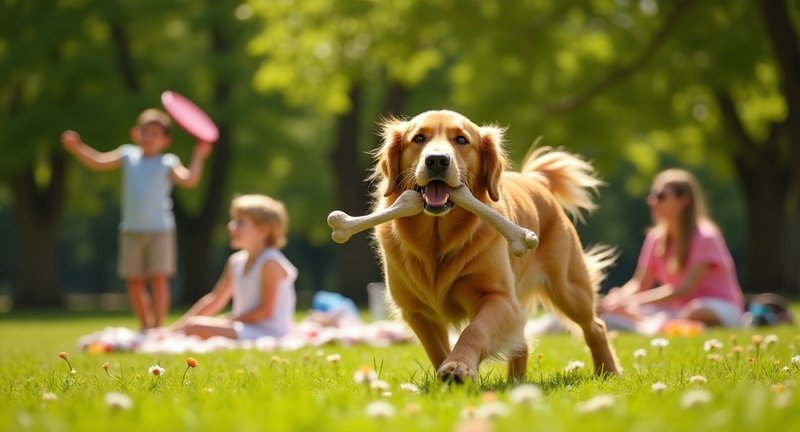
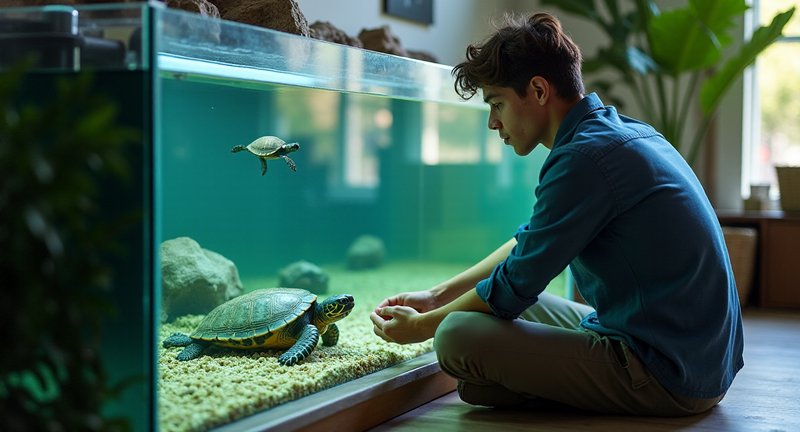






I love how you described the whole ‘rolling the dice’ with dog sizes! It’s so true! My own experience has been hilarious I got a dog expecting a small, cuddly companion, and well, let’s just say he’s now 70 pounds of pure lap dog ambition! It’s amazing how their size can surprise you, especially when they try to curl up on you like they’re still tiny. I definitely agree that the way they carry their weight makes such a difference some of the more compact, muscular ones look like little athletes, while others are just these elegant, graceful creatures. If you’re deciding based on size, seeing them in person is absolutely the way to go. Pictures just don’t do justice to their actual presence and personality!
I couldn’t agree more about Aussiedoodles being smart little tricksters! My neighbor has one, and it’s like the dog has us all figured out so clever! I even helped train her, and let me tell you, it felt like she was the one teaching me. It’s awesome that they have this balance of high energy for outdoor fun but are also happy to chill with you after. That versatility is what makes them such a perfect match for anyone with an active lifestyle who also enjoys a bit of downtime!
Oh, I absolutely love Bernedoodles! I’ve met a few, and they are such great companions so affectionate and fun-loving! The fact that they come in different sizes is really cool because it means there’s one for almost any living situation. I can definitely see how their calm but playful nature makes them fit into both energetic and relaxed homes. Plus, their low shedding is a lifesaver for allergy sufferers like me! These dogs really do seem to be the best of both worlds!
I can totally relate to the unpredictability of hybrid dogs! It’s part of the fun – never knowing whether you’re getting a laid-back day or a whirlwind of energy. The variety in appearance and temperament is what makes them so interesting! I’ve got a hybrid, and it’s amazing to see which traits from each parent show up in different ways. Definitely keeps life exciting, that’s for sure!
I couldn’t agree more with how you’ve captured the essence of choosing between two dogs that offer so much love and joy. It’s definitely like picking between flavors of ice cream – both are wonderful, just in different ways. I’ve noticed that the quiet, calm moments with a more reserved dog can be just as rewarding as the high-energy adventures with a more spirited one. It really does come down to what you’re looking for in a companion. For me, sometimes it’s those quiet, snuggly moments that make everything better, but I also love when my dog surprises me with a burst of playfulness. You’ve got me reminiscing about my own pup’s unique personality!
Ah, this comparison between Bernedoodles and Aussiedoodles really hits home! I love how you highlighted the unique personalities of each breed. It’s so true – the Bernedoodle’s cuddly nature versus the Aussiedoodle’s energetic vibe makes it such a tough (but fun) decision. Both bring something special to the table, and their different grooming needs just add to the charm of choosing between these two adorable doodle dogs!